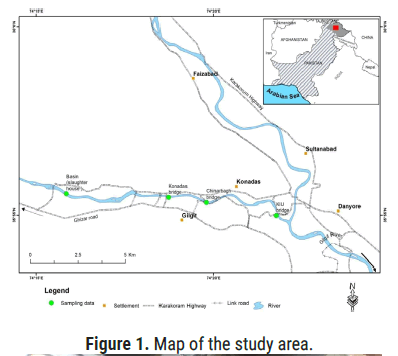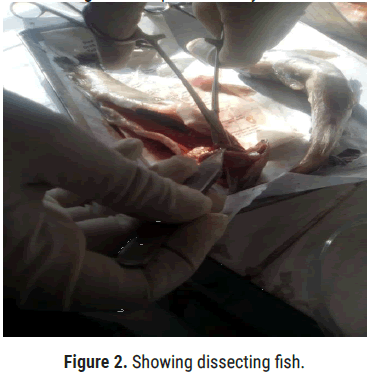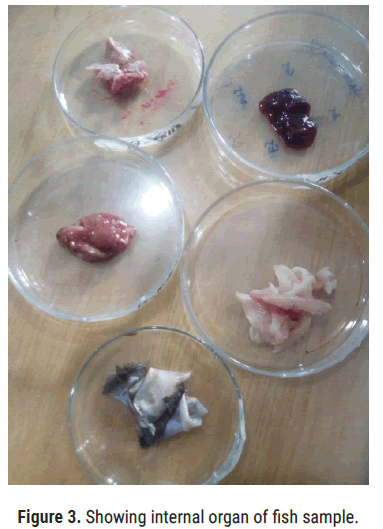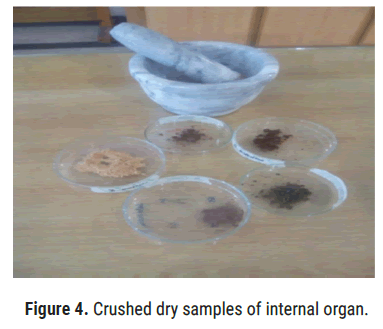Research Article - (2022) Volume 11, Issue 1
Trout is the general name for many species of fish belonging salmon family. Out of 39,900 species of vertebrates, about 21,723 living species of fish have been reported. In 1930, in Gilgit, a British officer introduced the species. It has large scales, dark and red spots on the sides that are thickly spotted. The purpose of the study was to investigate the presence and absence of heavy metals, Lead, Chromium VI, Arsenic and Cadmium in rainbow trout (Oncorhynchus mykiss) in the Gilgit river environment. Descriptive statistics of concentrated heavy metals in different organs of trout fish revealed that only chromium VI was found in range of (p<0.35) to (p>0.97) ppm was recorded. The maximum concentration of chromium was detected from gills (p>0.97) whereas minimum concentrations were observed from skin (p<0.35). The average concentration of chromium was noticed from muscles (p>0.53) of trout fish. The directional flow of municipal liquid effluents and solid waste in the river Gilgit at various points is the main precursor behind the situation. Before joining the river, there should be a proper drainage system to remove hazardous metals and chemicals.
Heavy metals • Rainbow trout • Chromium • Cadmium • Gilgit
Fishes are cold-blooded aquatic vertebrates which breathe using pharyngeal gills, propelling and balancing themselves through fins [1]. About 21,723 living species of fish have been recorded out of 39,900 species of vertebrates. Of these 8,411 are freshwater species and 11,650 are marine [2]. Freshwater fishes cover almost 45% of all fishes. An expected 15,000 fish depend on freshwater habitats. Fish forms highest among all vertebral groups apart from its economic importance [3]. Trout is the general name for many species of fish belonging salmon family [4]. Ammonia harms trout fish due to high temperature and ph. By increasing the pH of water from 7.0 to 7.3 and temperature by 10°C, the toxicity of ammonia is doubled. Trout is mainly affected by ferrous iron. With a relatively high saturation of oxygen in water, it oxidizes and precipitates in the gills. The maximum content of suspended matter in the water for farming of trout is not more than 10 mg/l [5]. The metabolic rate of fish is greatly affected by the concentration of oxygen in the nurturing environment. However, fish is not able to take in the food consumed when dissolved oxygen is low [6]. Several cultured and free-ranging fish species are considered a threat to infection and possible disease. Columnaris diseases also affect aquaculture species, mostly the catfish species, as well as many aquarium species [7]. It is difficult to determine the effect of climate change on fish populations because climate change affects a huge number of environmental factors that may affect various processes at different levels of biological organization [8]. The factors affecting the growth of salmonid fishes are divided into two categories, Physico- chemical and biotic [9]. Our aim of this study is to investigate the presence and absence of heavy metals in Trout Fish in the Yarkhoon River. Six heavy metals tested were Lead, Chromium VI, Arsenic, Cadmium, Mercury and Copper.
Research area
For analysis of heavy metals in trout fish, collected fish samples from four different points of Yarkhoon River. From each point, a single sample was collected. The current study was conducted to investigate the presence and absence of heavy metals in Trout Fish in the Yarkhoon River. The anthropogenic activities surrounding River, over growing eutrophication cause depletion of dissolve oxygen making the water unfit for survival of trout fish. Targeted points are as follow, Shoust Bridge, Darband, Zhupo and Meragram.
Sample collection method
Samples were collected from predetermined sites. Fish were collected with the help of a local fisherman by using various types of angling instruments. For transportation of fish sterilized large jars were used.
Sample transport method
Trout fish were collected in a decontaminated jar through the fishing net. After that transported the samples to K.I.U biological sciences lab within three hours.
Data collection tool
Data collection tool including, Gloves, GPS, fishing nets/rods, Camera, plastic bags, Coolbox/icebox and atomic absorption spectrophotometer.
Analysis of heavy metals in fish
Atomic absorption spectrometry was used for detection of heavy metals in trout fish like Cadmium, Lead, Arsenic, Mercury, Chromium and Copper.
Procedure
At first, brought fish in the biological lab after that calculate their weight by using electronic balance then measure the length via measuring scale, their length was 19.5 cm and weight was 101 g, dissecting fish sample through dissection box (Figures 1 and 2). Next, the internal organs like (gills, muscles, intestine, liver and skin) had been isolated and let them dry in the oven at 105°C for 24 hours (Figure 3). By using mortar and pestle crushed the dry samples and converted them into a powder form (Figure 4).

Figure 1: Map of the study area.

Figure 2: Showing dissecting fish.

Figure 3: Showing internal organ of fish sample.

Figure 4: Crushed dry samples of internal organ.
Atomic absorption spectrometry: For detection of heavy metals in Trout fish organs atomic absorption spectrophotometer was used (Tec comp, UV, dual beam, Model UV2300 II).
Statistical analysis: The collected data were analyzed by using statistical software Statistics 8.1 and MS Excel 2013 for mean, maximum values, minimum values, standard deviation, and standard error.
Heavy metals in trout are shown in Table 1.
| Body parts | Mean | Std. deviation | Std. error | 95% Confidence interval for mean | Maximum | ||
|---|---|---|---|---|---|---|---|
| Lower bound | Upper bound | Minimum | |||||
| Gills | 0.96 | 0.01 | 0.00577 | 0.9352 | 0.9848 | 0.95 | 0.97 |
| Muscle | 0.4833 | 0.07234 | 0.04177 | 0.3036 | 0.663 | 0.4 | 0.53 |
| Skin | 0.36 | 0.01 | 0.00577 | 0.3352 | 0.3848 | 0.35 | 0.37 |
| Mean | 0.6011 | 0.03078 | 0.01777 | 0.524667 | 0.677533 | 0.566667 | 0.623333 |
Table 1. Heavy metals in trout.
Descriptive statistics
Descriptive statistics of concentrated heavy metals in different organs of trout fish revealed that only chromium VI was found in above mention organs in range of 0.35 to 0.97 ppm was recorded. The maximum concentration of chromium was detected from gills 0.97 whereas minimum concentrations were observed from skin 0.35. The average concentration of chromium was noticed from muscles 0.53 of trout fish.
Fish samples were collected from different points of Gilgit River. For the detection of heavy metals such as Mercury, Lead, Arsenic, Cadmium, and Chromium in fish Atomic absorption Spectrophotometer (Tec comp, UV, dual beam, Model UV2300 II), was used at EPAGB Environmental Protection Agency Gilgit Baltistan lab. For fish all samples were taken from different points of Gilgit River, to detect the above mentioned heavy metals in fish organs i.e., Skin, Gills and Muscles, Atomic Absorption Spectrometer was used. None of the concentrated metals was detected from fish organs only Chromium was detected with different ranges. It ranged between 0.97 ppm and 0.35 ppm. Maximum concentration was detected from Gills 0.79 whereas minimum concentration was detected from skin 0.35. Our result was inconsonance with the study of Jezierska et al. [10]. He studied that, in initial growing stages, fish are specifically susceptible to water 40 pollution. Due to high influence of heavy metals the developmental processes of fish get disturb as a result the embryo get toxic effects in short metal concentration may pose death of embryo. The concentrated metals also cause decrease number and poor quality of larvae which make the body size small, increase the number of abnormalities and decrease their living process. This result follows the study of Eneji et al. who examined the concentrated metals in the organs of Tilapia Zilli and Clarias gariepinus of Benue River via atomic absorption spectrophotometer [11]. The results denoted that Tilapia Zilli gills possessed high concentration about (52.2%) of heavy metals; while small intestine contained (26.3%) and muscle tissue composed of very least amount (21.5%) of concentrated metals were determined. The current research somehow contradicts with Eneji where trout fish skin was used instead of small intestine.
The results correlate with the findings of Yılmaz et al. studied water contamination by concentrated metals [12]. The most common is Chromium pollution from industrial areas which can affect pure aquatic life; ecological unit and human health are directly or indirectly their aim was to rule out the consumption of Chromium hexavalent by freshwater fishes. The result revealed that maximum range of Chromium was found in gills while minimum and average range was recorded in rest of the fish organs. The present study is in corroboration with the study of Velma et al. assessed that, Chromium is an element which is found naturally in soil, rocks, animals and plants [13]. It usually occurs in a trivalent form, thus insoluble in aqueous solution. Heavy industrialization and manmade activities has led to increase in the amount of soluble Chromium. The results revealed that, Chromium poses serious and harmful impact on fish, at cellular, biochemical and genetic level. Chromium is an essential metal present in a considerable hazard to in an aquatic life.
Aslam and Yousafzai assessed the toxic impact of Chromium in fish, as a result it highly impact on fish behavior such as hypertrophy (increase in size of skeletal muscle) and paraplegia (impairment in motor or sensory function of the lower extremities) at gill epithelium, irregular swimming and 41 suspended feeding [14]. Moreover, due to its toxicity whole ecosystem become destabilized. The finding of Yousafzai was correlated with the current research in same way fish Gills were highly affected due to toxicity of Chromium in water. Afshan et al. worked on the effects of heavy metals on fresh water fish [15]. The results of Afshan somehow deviated with the current research, fish were exposed to multiple metals and the effects of these metals were also detected in organs like, gills, muscles.
Fawad et al. conducted experimental study in order to recognize the value of bioaccumulation of Chromium in the gills, intestine, skin and its severe toxicity to gold fish fingerlings via Chromium chloride salt solution, the results revealed that Chromium has toxic effects on gold fish organs as well as on other aquatic life [16]. The outcomes of Fawad contradicts with our study gold fish fingerlings were exposed for 96 hours to Chromium chloride salt, and the dose of chemicals given to the fingerlings were elevated day by day.
Stevens et al. analyzed severe toxicity test of Chromium on early life stage of steelhead trout [17]. 96 hour LC50 4,400 μg/l Chromium was detected in two-month juvenile fish. The Stevens findings deviated with the present research where fish were exposed to Chromium which in turn causes complete mortality of 495 μg/l and also decrease in hatching value [18].
Although the presence of same metal in different parts (gills, muscles, skin) of trout fish was determined using atomic absorption spectrophotometer, also suggestive of ample absorption of the Chromium VI from chemically contaminated water. The directional flow of municipal liquid effluents and solid waste in the river Gilgit at various points is the main precursor behind the situation. It is mandatory to have waste from workshops and the other inorganic sources elevated the metal content in the initial points of the river. The deflocculating and dissociation factor was considerably low. It was also observed during the course of study and the observation of local fishermen, the population of fish is declining gradually in addition to the very stunted growth, and the factor behind the reason may be the pollution and subsequent fragile eco-system of the river.
I would like to devote my family to this research paper for their generous support and prayer.
Citation: Ali S, et al. Determination of Heavy Metals from Rainbow Trout (Oncorhynchus mykiss) in Gilgit River Pakistan. J Biol Today's World, 2021, 10(6), 001-004.
Received: 03-Aug-2021, Manuscript No. JBTW-21-39310; Editor assigned: 06-Aug-2021, Pre QC No. JBTW-21-39310(PQ); Reviewed: 20-Aug-2021, QC No. JBTW-21-39310; Revised: 25-Aug-2021, Manuscript No. JBTW-21- 39310(R); Published: 03-Sep-2021, DOI: 10.35248/2322-3308-11.1.005
Copyright: © 2021 Ali S, et al. This is an open-access article distributed under the terms of the Creative Commons Attribution License, which permits unrestricted use, distribution, and reproduction in any medium, provided the original author and source are credited.